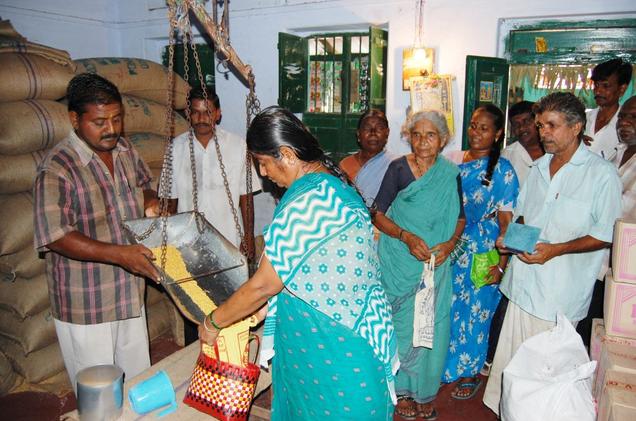The Targeted Public Distribution System (TPDS), the largest beneficiary-centric programme in India covering 81.35 crore population, is a well-planned policy with noble intentions meant to provide essential food commodities at affordable prices. However, it has been criticised extensively for its key operational shortcomings like:
- Inaccurate mapping of beneficiaries
- Leakage of food grain and diversion of food grains
- Inefficient supply chain management
- Lack of transparency and accountability
- Limited portability
The Centre has initiated a technology-driven SMART-PDS to address challenges like inefficient supply chain, transparency and portability, but it fails to address challenges posed by human psychology.
Here are three key structural deficiencies in the current policy.
- Top-down program with the Central Government allocating resources to states based on procurement from net food surplus states.
- Like most government programs, it falls in the lowest rung of Friedman’s Law of Spending hierarchy (each participant in the supply chain has weak incentive to economize and seek highest value)
- It is not a Spontaneous Order created by the unplanned voluntary exchanges between the participants but a centralised system handed down by the Government
How do we overcome these challenges?
Gear Reversal: A Bottoms-Up Drive with AI
Apply AI on big data sets like crop yields and consumption patterns from various states to identify demand-supply gaps. Thus, instead of a top-down bulk-allocation approach by the Centre, state governments can leverage AI to estimate grain requirements linked to on-ground demand from various districts.
The SMART-PDS, expected to provide data on consumption patterns, when integrated with the public health care system can identify prevalent nutritional deficiency diseases. This can turn our food security program into a nutritional security champion when AI is applied to data from district health centres to raise demand that is better aligned with nutritional gaps faced by the targeted beneficiary group in a district.
A decentralised demand planning approach will serve beneficiaries more efficiently, delivering nutritional and food security. While the Centre can focus on efficient bulk procurement and nutrient fortification, the states are incentivised to provide accurate demands for their nutritional gap fulfilment. This will eventually expand the variety of grains covered under the scheme and reduce demand pressure on surplus states like Punjab and Haryana to grow water-intensive crops (wheat and rice). This is an ecologically sustainable long-term program than the current top-down approach of surplus allocation of grains.
Better nutritional security will mean a healthier and more efficient workforce in states that can attract better private investments. The result is more job creation and economic progress of the states. On the other hand, AI driven health record analysis will scale up the identification of malnutrition at grass root level with speed and help in combating the same. Thus, a decentralised demand process will have a compounding effect on the overall economy.
Rule based Incentives that matter
SMART-PDS coupled with the implementation of One Nation One Ration Card (ONORC) can equip Fair Price Shops (FPSs) with ePOS devices. A grievance redressal module can be plugged into this digital ecosystem to enable beneficiaries register complaints or rate an FPS. These initiatives can feed granular level data to AI algorithms.
AI can bring in rule-based incentive schemes that will eventually shift user behaviours. An allocation-cum-margin system based on performance of ration shops will incentivise FPS to seek high ratings from beneficiaries because grain allocation in future is linked to ratings. This will not only reward the better performing shops but also create competition and bring beneficiary satisfaction into the equation that has been missing so far.
When margins are linked to quantity of grains sold but grain allocation itself is linked to beneficiary ratings, it will incentivise customer centricity amongst FPS owners. The 100% portability with ONORC will also incentivise customer centric behaviour as FPS owners wouldn’t want to lose beneficiaries to neighbouring ration shops.
Rule based incentive schemes powered by AI can be designed for the transport and warehouse partners. Minimum wastage algorithm rules will automatically pick up the most efficient routes, transport companies and warehouses across the supply chain. Payments to these partners could be linked to delivering minimum wastage during the transport or storage process. Also, a Public-Private Partnership (PPP) approach to supply chain management will greatly enhance competition and outcomes.
Incentives coupled with competition can move transport, warehouse and ration shop players up the Friedman’s Law of Spending hierarchy.
Mimicking Spontaneous Order with AI
In the real world, efficiencies emerge as Spontaneous Order systems evolve with time, participation and competition. GPS tracking data under the SMART-PDS can enable AI to identify more efficient transport routes and storage facilities to reduce time, wastage and logistic costs. AI algorithms can create competition by rewarding efficient logistic vendors or minimise storage waste by analysing spare warehouse capacity in a given location during a given season.
The future of Public Policy looks promising in the era of AI but we need to watch out for existing biases in historical data, build the desired skill set and promote a culture of analysis that are some of the prerequisites for this leap into the realm of Responsible AI.
Post Disclaimer
The opinions expressed in this essay are those of the authors. They do not purport to reflect the opinions or views of CCS.






